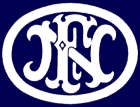 |
 |
 |
|
|
|
|
Firearms Technical Trivia, April 2001:
 |
 |
 |
1. BACKGROUND
Fabrique Nationale's (FN) Fusil Automatique Legere (FAL, or "Light Automatic Rifle") is one of the world's most prolific self loading battle rifles. The brainchild of gifted FN designer Dieudonne Saive, the FAL was adopted by more that ninety nations and license produced in more than ten of those, earning the sobriquet "the free world's right arm." It is the definitive western postwar battle rifle, emblematic of NATO much as the AK-47 was of the Warsaw Pact. The FAL has been in service with one army or another since 1954 and has earned an enviable reputation for reliability and durability, serving with distinction in such disparate places (and climates!) as Vietnam, the Sinai, the Brazilian rain forest, Western Europe, and the arctic regions of Canada. It is a timeless design, considered by many to be unequaled in the field of military self loading rifles. In those armies that phased the FAL out of service, the decision had more to do with standardization of the 5.56x45mm cartridge than any failings on the rifle's part, and in at least one, a 5.56mm version of the FAL has been developed.
Enthusiasm for the FAL has not been restricted to the military. Semiautomatic versions of the FAL are very popular with US shooters. As luck would have it, there has been no time like the present to pursue an interest in this fine old warhorse. The prospective FAL-phile has two ways to go with respect to obtaining his or her rifle. On the one hand, there are no fewer than six different companies manufacturing semiautomatic FAL rifles on a production line basis at this time. One can buy a FAL made by Century International Arms, Israel Arms, Olympic Arms, Hesse Arms, Entreprise Arms, or DS Arms. Prices range from between $500 and $600 to in excess of $1,600, with most coming in at a retail range of between $850 and $950. Additionally, the market is currently saturated with accessories and 7.62mm NATO ammunition, making the FAL inexpensive to own and shoot. With the exception of DS Arms' higher end rifles, the FAL clones are all "parts guns." Specifically, when a military FAL is imported, the original upper receiver is destroyed in accordance with federal statutes and regulations. The remaining parts, including the barrel, furniture, lower receiver assembly, and the rest of the rifle, are then assembled on a new lower receiver that has not been machined to permit the installation of the selective fire components. During assembly, the requisite number of domestically manufactured parts are installed so as to ensure the finished product's compliance with title 27, Code of Federal Regulations, Section 178.39 (the regulatory amplification of Title 18 US Code Section 922r). The rifles are then refinished, packaged and distributed for resale to consumers.
In addition to pre-assembled rifles, the market is also awash in components; bare upper receivers, parts sets (all components less the destroyed upper receiver), legislatively necessary domestically manufactured parts, and aftermarket parts and accessories - all the enterprising cruffler needs to legally, and safely, assemble a FAL at home. Upper receivers are made domestically by DS Arms, Hesse Arms, Entreprise Arms, and Olympic Arms. Metric pattern parts kits available include South African R1 and R3 kits, Austrian StG58 kits, Belgian FAL kits, and Brazilian Imbel M964 kits. Inch pattern kits available include UK and Australian L1A1 kits. Domestic components used to bring the finished rifle into legislative compliance are manufactured by DS Arms, Entreprise Arms and Hesse Arms.
The advantages to building your own FAL are many, and include the ability to spread the costs out over an extended time, personal selection of indivdual components and finishes, personal selection of mechanical charateristics such as the headspace dimension, an intimate knowledge of the FAL and how it functions, as well as the intangible rewards that come from a job well done and having built something good with your own hands. As attractive as the idea of building one's own FAL is, there are some pretty large stumbling blocks that stop many people from trying their hand. Among these are the procedures for barreling, headspacing, and installing muzzle devices, each of which requires a bit of specialized knowledge and equipment.
Potential problems aside, we were curious. Just how difficult was it to build a FAL in a reasonably well equipped home workshop? Beyond killing the cat, curiousity also gets crufflers to spend a lot of time and money on gun related projects. So we succumbed, and decided to attempt to build three FAL's. Specifically we intended to build a South African R1 kit on an Imbel Type 03 receiver, an Austrian StG58 kit on an Entreprise Type 01 receiver, and another South African R1 kit on an Entreprise Type 03 receiver. To make the test more "realistic," all rifles were to be assembled in the basement "workshop" (and we use that word very loosely!) of one of the CRUFFLER.COM staffers.